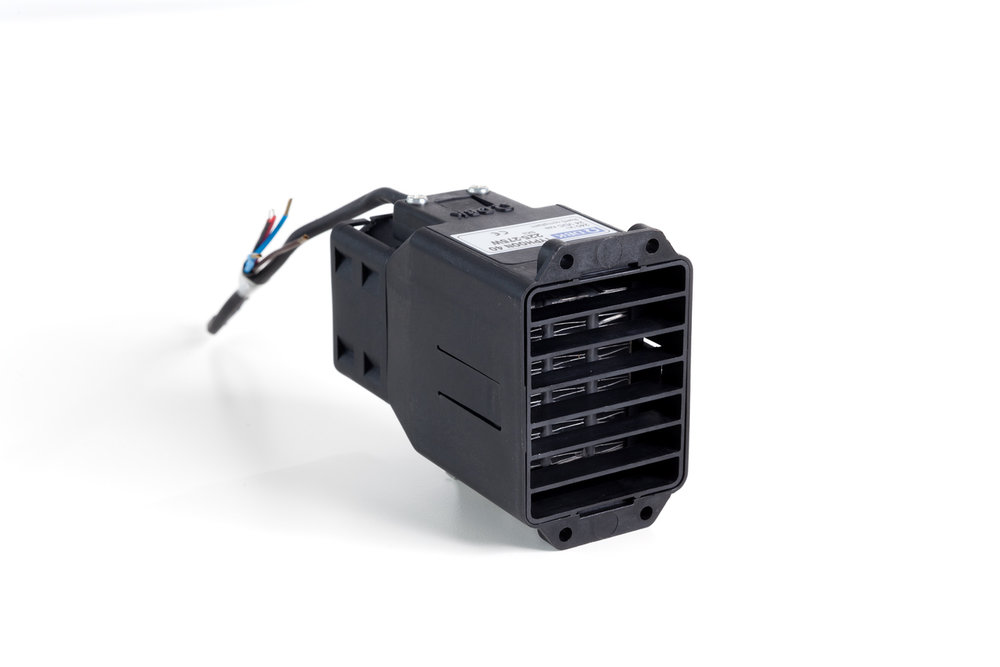What is a PTC Fan Heater?
A PTC Fan Heater is a PTC Air Heater with a fan that helps move the heat output to nearby spaces not directly in contact with the heating components. The rapid and efficient heat transfer from the resistive ceramic disk makes the device more energy efficient than a traditional resistive fan heater. These heaters are unique in that they automatically adjust the amount of temperature increase based on the ambient temperature.
Combining PTC ceramic heaters with a cooling fan provides a broader range of temperature and moisture control. This is especially true in tightly packed electronic cabinets indoors and outdoors in various climate conditions.
DBK Fan Heaters range from 10W to 800W, 12-24V, and high voltage 115-230V heaters. The fan heaters have separate connections for the heater and fans for more efficient operation. These lightweight, high power-to-size ratio components are pre-wired and ready for installation on DIN Rails.
What’s the advantage of a Fan Heater over other heaters?
Traditional heating elements can be problematic in harsh conditions. Separate electric heaters, cooling fans, and control components take up too much space. The safety and dependability of the PTC Fan Heaters and their compact size offer the best option for design engineers.
Durability, reduced repairs, and downtime: The ceramic materials used in PTC heaters are much more durable than typical resistive elements greatly improving the durability and dependability of the components. There is no chance of burned out elements or coils with ceramic heaters.
Ease of Installation in Equipment Cabinets: DBK’s PTC Fan Heaters are lightweight compact designed for mounting in any orientation. All are UL recognized components and UL508A certified for industrial control panels. These self-regulating temperature heaters are pre-wired with separate circuits for fan only operation.
Can I use a PTC Fan Heater for moisture control?
Using the PTC Fan Heaters in combination with our temperature control sensors can help maintain the cabinet temperature a few degrees above ambient preventing moisture build-up on cabinet components. While the fan heater is not a replacement for humidity control with an additional temperature controller, it will meet most needs of reducing moisture.
What is the difference between a PTC Fan Heater and a PTC Radial Fan Heater?
They mainly differ in their design and the available power levels. Cirrus Fan Heaters use an axial fan and can be directly installed into customer housings. LA09 Fan Heaters use a radial fan and require an additional housing for mounting. Further technical information can be found on the product pages.
How can I control the output of a PTC Fan Heater?
The power of a PTC Fan Heater cannot be regulated by changing the voltage. However, it is possible to adjust the power using a classic 2-point control or PWM control. Please note that the fan speed will not be reduced. The power can also be adjusted - if available - by wiring different power levels.
Are PTC fan heaters suitable for operation in wide voltage ranges?
No. PTC Fan Heaters can only be operated with the supply voltage specified on the type plate.
Can I operate fan and heater separately? If yes, what must be considered?
Yes, the fan and heating element can be operated separately. This enables recirculation operation for cooling. However, it must be noted that the heating element must not be operated without the fan.
Is it possible to operate PTC Fan Heaters without an additional temperature fuse?
Due to the PTC effect, there is no need for a thermal fuse in most cases. However, an additional thermal fuse or limiter may be necessary in applications where the permissible temperatures are below the PTC self-limiting temperature.
Which factors must be considered when connecting a PTC Fan Heater?
The connection must be installed according to the type plate. The heating element may only be operated in combination with the fan.
What are typical applications of PTC Fan Heaters?
PTC Fan Heaters are suitable for temperature control, frost prevention and protection against moisture in housings of all kinds, such as in Control Cabinets, Automated Teller Machines (ATMs), Ticket Vending Machines, Parking Ticket Terminals, Display Panel Heating, Traffic Monitoring Systems, Access Control Systems, Fuel Pumps, Electric Car Charging Stations, Telecommunications, Energy Ports, Building Security Systems, CCTV, Building Management Systems, Temperature-sensitive Product Transportation, Landscaping Systems, 3D Printing Equipment, and much more.




